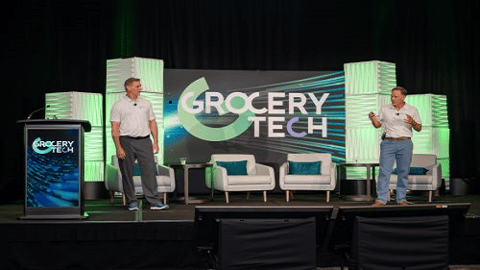Empowering Local Grocers Through Tech and More
While the latest tech solutions can certainly help grocers streamline their businesses and lift their bottom lines, how can smaller food retailers compete against the sheer scale and deep pockets of their larger rivals? That was the question that the final session of Progressive Grocer’s recent GroceryTech event, which took place June 10-12 at the Marriott Dallas Uptown, set out to answer.
Featuring Elizabeth Lafontaine, director of research at Santa Cruz, Calif.-based location intelligence platform Placer.ai; Liz Abunaw, CEO of Chicago-based indie Forty Acres Market; and Scott Kaverman, senior director, strategic pricing at St. Louis-based regional player Schnuck Markets, the session was guided by PG Senior Editor Lynn Petrak to a strong finish, not just for the day’s programming, but also for the third annual event, which adjourned immediately after.
[RELATED: Midwest States Work to Support Grocers in Rural and Underserved Areas]
At a time of rising competition, consumers willing to shop at multiple stores, and increasingly blurred lines between retail channels, the grocery store operators on the panel spoke about how they strive to differentiate themselves. For Schnucks, that means adopting such technology as inventory management and floor-cleaning robots, smart carts, electronic shelf labels, AI-enabled salad bars, and improved personalization through its rewards app. “We’re still leaning into the fact that consumers really care about still having a part of their value proposition that they see with us as having a clean and safe store to shop,” noted Kaverman.
Meanwhile, for Forty Acres, which Abunaw jokingly admitted was “about as tech-forward as the 1900 general store,” the emphasis is on interpersonal relationships. “What drives people to Forty Acres is the fact that technology isn't the barrier between them and the business,” she explained of the business, which does deliveries and pop-up stores but will soon open its first permanent physical location. “They like with us that they speak to real people, they know their delivery drivers, [and] when they go to a pop-up, it’s the same team week after week after week. And building that familiarity and that relationship with the customer is what keeps them coming back,” along with strong word of mouth from satisfied customers.
Further, Abunaw observed that “when you don't have technology to do things for you, for your staffing or employees, process becomes the end all and be all. So we make sure that things run properly by having really good processes and really good training.”
She added: “I think for small grocers, a lot of the tech that we see … is beyond our capital investment ability at the moment, and so you kind of take the pieces that you can where you can.” Regarding that last point, after starting off with emailed order forms for customers, Abenaw proudly revealed that Forty Acres was “about to launch an all-new website that we actually had built for us that is a better user experience, lets them make their payments easier.”
Discussing what issues were most on shoppers’ minds, Lafontaine affirmed that “value is the No. 1 thing that consumers are thinking about when they're making a retail decision,” but the definition of value goes beyond just price.
“When we think about independents and smaller regional chains … a lot of these [businesses] know that they’re never going to be the cheapest retailer on the block,” she said. “Value is not just necessarily the lowest price; it’s not necessarily the highest level of promotions. There’s a lot of factors that can go into value. It’s sometimes the in-store experience, it’s the conveniences, it’s the services that a retailer is providing. It’s that when a consumer leaves that retailer, they feel like they derived as much value out of that purchase as possible. So I think for regional players, it is leaning into the specialties, leaning into the services, leaning into the relationships. Those are areas where retailers can provide value that’s not necessarily based on pricing.”
[RELATED: Food Lion Exec Spills Secrets of Attracting Top Talent]
However, Kaverman was quick to remind attendees that while value may be more than just price, “ the foundation of that is price. You have to have a very concrete, clear, holistic strategy, both at base pricing and promotional pricing. You have to make sure you’re leaning into what your key value items are for your customer base, making sure you’re providing transparent and trustworthy and consistent pricing across those items so you’re not losing trips there that are poor basket builders.
"Doubling down on having a really good concrete promotional strategy to supplement that is huge," he continued. "And that can’t just be standard discounts. It’s got to be very tailored, strategic, different promotional mechanisms that consist of different dollars off percents, off multi-buys, different structured-layer promotions with points or dovetailing with, for us, a rewards program that is pretty robust and offers a lot of personalized offers that can really differentiate us among our competition.” He also recommended “a robust private label program [in which] you can build down differentiation, offer quality goods that are unique to [you] and really make sure that you get some of that loyalty that other retailers and competitors can offer.”
Talking about how to create the perception of affordability, Abenaw said: “One of the cornerstones of value is quality. People are willing to pay for quality. As a grocer, it starts at the buy. For me, I am always looking for those one-offs, like somebody’s long on cabbage and if I can buy it up at a really great price, then I’m at 49 cents a pound, whereas Walmart’s at 69 cents a pound, and I win. I think all of those things come together to offer that value, which does start at the price perception, not necessarily what your exact price is, but what perception people have of your pricing.”
When it comes to freeing up associates’ time to focus on more meaningful, customer-facing tasks, tech is definitely useful, with the added bonuses of helping to minimize overall waste and boost efficiency, according to Kaverman, who noted: “We’re trying to leverage a lot of that innovation to drive a lot of the savings to redeploy in labor and then also to continue to offer incremental value by investing further in price to try to combat some of the pending tariff inflation that we have ahead of us.” Schnucks also reinvests in “continuous learning opportunities and development to make sure that [we’re] attracting new and youthful labor into our workforce.”
Abenaw’s goals as an employer are “to make Forty Acres sticky once people get in, so they can see a pathway in grocery, and then to attract people” by paying them competitive wages. “I’m doing whatever I can to show that they are valued so that they want to learn this industry [and] want to stick with us and hopefully even refer friends, because good people attract more good people,” she continued.
Abenaw and Kaverman both affirmed the importance of grocery stores as “third spaces” that offer opportunities for human interaction beyond any technological conveniences, and Lafontaine brought the session to a satisfying close by observing: “A lot of times, the retail industry talks about experiential retail and all of these innovative things, which are certainly great, but I think sometimes we kind of lose the focus that ultimately, consumers just want a good experience in store, and that comes from having a personal connection to the people, having a personal connection to the brand, having the products and the services that make most sense to them at any given time. So giving consumers a good retail experience is really where grocery can win going forward.”






